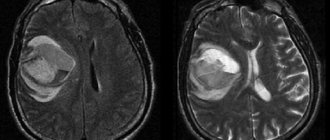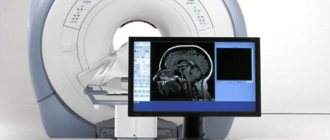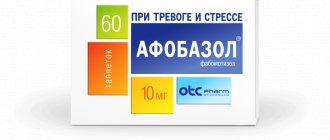Headaches are one of the most common reasons why patients turn to neurologists. All factors that cause such disorders are conventionally divided into 2 groups: organic (they can be seen on MRI images) and functional. MRI is performed specifically to detect organic abnormalities of the brain, which include:
- tumor formations;
- hydrocephalus (accumulation of cerebrospinal fluid in the ventricles of the brain);
- aneurysms, stenoses and other vascular lesions;
- sinusitis, sinusitis and other inflammatory phenomena in the paranasal sinuses;
- cerebral hemorrhage;
- inflammation of the brain and its membranes (encephalitis, meningitis);
- congenital pathologies of brain structures.
Very often, the root cause of the disease cannot be seen in the images, and then the doctor determines its etiology based on indirect signs.
Another cause of migraine may be cerebral circulatory disorders, for which an MRI procedure in angio mode is prescribed. For diagnostic accuracy, the ideal option is to do an MRI at the time of an attack, when you can assess the intensity of blood flow and identify acute circulatory disorders.
During the procedure, radiologists can detect the so-called. "cervical artery syndrome", which can affect one side or spread to both vessels. This entails paroxysmal pulsating headaches, provoked by compression of the cervical artery and aggravated by head movements. The root cause of this phenomenon is usually trauma.
How is MRI performed for migraine?
For complaints of recurrent headaches, MRI is prescribed to differentiate from severe organic brain lesions that have a structure similar to migraine. The pain caused by migraine cannot be eliminated with analgesics. Most often, people begin to uncontrollably take pills, which only worsen their condition.
When conducting a tomography study for migraine, the doctor follows a certain algorithm - scanning the brain, vascular bed, and cervical vascular system. If necessary, angiography data of the cervical vessels is added to this to assess the state of blood flow in the arteries.
On MRI images, migraine is manifested by multiple foci of ischemic origin, blood flow disturbances (recorded by a tomograph only during attacks). Immediately before a migraine attack, the blood vessels in the brain dilate, after which a sharp spasm occurs.
Diagnosis of migraine and MRI
Diagnosis of migraine is usually carried out in two or three stages. The patient is examined and anamnesis collected during the initial consultation with a neurologist. Next, depending on the indications, the specialist prescribes treatment for the patient (for example, physical therapy and medications) or a series of examinations, based on which the doctor can make the correct diagnosis. Such studies include magnetic resonance imaging: it is an important diagnostic method, because the images obtained during the MRI study provide a complete picture of the location and nature of the identified pathology.
MRI of the brain is the main study in the diagnosis of migraine, which in most cases is irreplaceable. MRI scanning is carried out in three mutually perpendicular projections, thanks to which the radiologist can identify various pathological processes and see any, even the smallest, changes in the brain. The high contrast of the resulting images makes it possible to evaluate in detail the cortex and white matter of the brain, the basal subcortical ganglia, large arteries included in the slice, the brain stem and the contents of the posterior cranial fossa (which in turn is poorly visualized on CT). MRI for migraine is required by a neurologist to make a clinical diagnosis and plan effective treatment. Often, the doctor additionally prescribes magnetic resonance angiography.
Headaches after MRI
Although tomography is considered a completely safe procedure, many patients complain of increased headaches, often accompanied by nausea, general weakness, and dizziness.
Painful sensations are concentrated in the area of the back of the head or the crown. Doctors say that this phenomenon is associated with the increased sensitivity of migraine patients to external factors and is temporary. In most cases, this condition goes away within a day after the study, and pain of this nature is easily eliminated with pills. Therefore, you should not be afraid of the procedure.
If the pain does not go away after 24 hours, contact your doctor, who will conduct an examination and prescribe treatment. Usually in such a situation, neurologists recommend, in addition to medications, to drink less fluid, not to strain either mentally or physically (it is best to wait for the condition to stabilize at home, observing bed rest). MRI cannot cause any harm to health, since it is non-invasive and the safest of all hardware diagnostic methods existing today.
How is a migraine different from a headache?
It is very important to differentiate migraine from headache, which, as a rule, signals hidden pathologies.
Migraine, as we have already said, is most often a consequence of deterioration of blood supply to the brain due to vascular spasm or due to dilation of cerebral vessels with a subsequent increase in vascular permeability, while the following conditions can be the cause of headache:
- increase and decrease in blood pressure;
- cerebral aneurysm (minor and rare painful sensations may be a sign of the presence of an aneurysm);
- swelling (persistent headache accompanied by vomiting without previous nausea).
From the above, it becomes clear that mistaking a headache for a migraine in some cases can have undesirable consequences, and the time necessary for adequate treatment may be missed. It is also known that patients experiencing migraine usually describe it as throbbing in the temples, but throbbing headaches can be caused not only by migraines, but also by ear infections and sinusitis. Consequently, only an experienced clinician (neurologist) will be able to clinically differentiate migraine from headaches of other origins.
If the attending physician wants to exclude or confirm the presence of a brain tumor as a possible cause of the headache, then the patient may be prescribed a contrast-enhanced MRI. In the presence of a tumor, MRI allows one to identify, localize, and evaluate the structure, size and relationship of the tumor with surrounding tissues and midline structures of the brain.
One of the advantages of the MRI method is the absence of harmful ionizing radiation, which makes the examination absolutely safe for the patient’s health.
It should be noted that many diseases, including those that can lead to disability, at the initial stage have only one pronounced symptom - headache, which makes it possible to suspect the disease. But even in these cases, an MRI will help identify the cause of the headache: the scan visualizes structural changes in the brain that are characteristic of each individual disease, which makes it possible to predict the course of the disease and begin treatment on time.
Symptoms and signs of migraine
In most cases, migraine manifests itself, the symptoms of which depend on the cause of the pathology, severe throbbing pain in the head. In addition to severe pain with throbbing, hemicrania is characterized by:
- nausea or vomiting, loss of appetite and often slight weight loss;
- dizziness;
- irritability up to attacks of aggression;
- drowsiness;
- increased sensitivity to smells, tastes and light.
Symptoms depend on the stage of development of the pathology. After the migraine attack passes, patients usually feel well. Experts identify the following stages of disease development:
- precursors of migraine are characterized by manifestations of depression, fatigue, and irritability several hours before the attack. Some patients, on the contrary, feel an increase in activity and appetite;
- aura, which is a reflection of certain processes occurring in the brain that are associated with the mechanism of migraine development. The duration of the aura is on average up to 30 minutes, but in some cases the stage can be longer. This stage is characterized by visual effects such as blind spots, flashes of light, sensory effects such as numbness or tingling sensations, problems finding words or difficulty speaking. Symptoms may appear individually or in combination;
- The headache can last from 2-3 hours to several days. Very strong pain of a bursting or pulsating nature can cover the entire head or be localized in the temporal region. At this stage, nausea or vomiting attacks and a desire to hide in a dark room alone are common;
- resolution follows the headache phase and is accompanied by fatigue, depression, or irritability. Concentration is difficult. Symptoms persist for up to a day.
Reasons for the development of the disease
The reasons may be different and not always obvious. Provoking factors may include:
- Narrowing of the lumen of arterioles, which leads to disruption of blood supply to the brain.
- Stress.
- Malfunctions of the endocrine system.
- Heredity, predisposition to chronic hypertension.
- Overwork.
- External stimuli - noise, vibration and others.
- Severe mental and emotional stress.
- In some cases, an attack can be triggered by certain foods (fish, cheese, nuts and others).
What is migraine?
A migraine is a throbbing headache, often with nausea and vomiting. During an attack, many find it difficult to look at bright lights and hear loud sounds. It seems that these external irritants multiply the suffering and make the pain simply unbearable. After an attack, drowsiness, weakness, and apathy may occur. An important feature of migraine is that it does not go away on its own and will last throughout your life. The intensity of the pain, the duration of the attack and the localization can only change - they sometimes “migrate” from one part of the head to another.
Treatment
If a patient is diagnosed with migraine, the doctor selects treatment taking into account many factors, including examination results:
- Drug therapy is symptomatic. The main goal of drug therapy is to reduce the intensity of attacks. The doctor selects tablets for migraine taking into account the form of the disease, the patient’s health condition and the nature of the attacks;
- for minor pain, non-steroidal anti-inflammatory drugs can be prescribed;
- for infrequent attacks and mild forms of the disease, anilades in combination with the effect of vasoconstriction are effective against migraines;
- triptans for migraines with a vasoconstrictor effect.
It is important to remember that migraine medications are selected for the patient and prescribed only by a doctor, since uncontrolled use of medications can cause side effects and complications that will lead to serious deterioration in health.
Non-drug methods include organizing a work and rest schedule, eliminating foods that stimulate attacks, giving up alcohol and smoking, selecting a diet, etc.
Among non-drug methods, mention should be made:
- neck massage;
- acupuncture;
- acupressure.
Specialists at the Pain Treatment Center of JSC “Medicine” (academician Roitberg’s clinic) approach the treatment of migraines in a comprehensive manner. An integrated approach allows us to minimize the impact of the disease on the patient’s body and the patient’s health as a whole. The combination of various methods of rehabilitation and therapy allows you to achieve excellent results in a short time. Contacting the neurologists of JSC "Medicine" (clinic of Academician Roitberg) provides the opportunity to significantly improve the quality of life.
Migraine in children
Children can experience the same types of migraines as adults. Children and teenagers, like adults, may also experience depression and anxiety disorders along with migraines.
Until they are adults, teenagers and children may have symptoms on both sides of the head. Children rarely have headaches in the back of the head. Their migraines typically last between 2 and 72 hours.
There are types that are most common in children. These include abdominal migraine, benign paroxysmal vertigo and cyclic vomiting.
Abdominal migraine
Children with abdominal pain experience abdominal pain instead of a headache. The pain may be moderate to severe. Typically the pain occurs in the middle of the abdomen, around the navel. However, the pain may not necessarily be located in this area. The stomach may simply “ache.”
Your child may also have a headache. Other symptoms include:
- lack of appetite
- nausea with or without vomiting
- sensitivity to light or sound
Children with abdominal migraines may also develop more typical symptoms seen in adults.
Benign paroxysmal vertigo
Benign paroxysmal vertigo can occur in babies who are just starting to walk, or simply in young children. This occurs when your child suddenly loses the ability to stand on his own feet and refuses to walk or walks with his legs wide apart, as if he is staggering. He may feel nauseous. He may also experience a headache.
Another symptom is rapid eye movements (nystagmus). The attack lasts from several minutes to several hours. Sleep often stops these symptoms.
Cyclic vomiting
Cyclic vomiting is common in school-age children. Forced vomiting may occur four to five times per hour for at least one hour. Your child may also suffer from:
- stomach ache
- Headache
- sensitivity to light or sound
Symptoms may last for 1 hour or up to 10 days.
Between episodes of vomiting, your child may act and feel completely normal. Attacks may occur once a week or less frequently. Symptoms may begin to appear in a pattern that is easily recognizable and predictable.
Symptoms of cyclic vomiting may be more noticeable than other migraine symptoms experienced by children and adolescents.
Diagnostics
To make a diagnosis, the patient is examined and interviewed. An accurate diagnosis can only be made if the symptoms characteristic of migraine are distinguished from the manifestations of other diseases with similar symptoms. The following diagnostic measures are carried out:
- MRI.
- Electroencephalography.
- Angiography.
For migraines, examination usually does not reveal any organic cause. Diagnosis is made based on symptoms and whether they meet the criteria for migraine. Evaluated:
- Nature of pain.
- Its localization, intensity.
- Presence of vomiting and nausea.
- Presence of photophobia.
- The nature of the aura.
If you do an MRI when you don't have a headache
Multiple ischemic foci in vascular dementia on MRI: lack of memory for recent events and inappropriate behavior are not signs of old age; timely diagnosis of dementia and pathogenetic therapy will help slow down the progression of the disease
MRI is an examination that is performed not only for headaches. Magnetic resonance imaging will help determine the causes of the following complaints:
- short-term loss of consciousness unexplained by primary diagnosis;
- flickering of spots before the eyes, progressive deterioration of vision (as part of a comprehensive ophthalmological diagnosis);
- increased blood pressure, resistance to taking antihypertensive drugs;
- periodic nausea, vomiting when changes in the fundus are detected (signs of increased intracranial pressure);
- epileptic seizures;
- memory impairment, dementia (dementia);
- constant ringing in the ears;
- lack of coordination of movements (shaky gait, dragging of the lower extremities, etc.);
- dizziness.
The doctor determines not only the type of examination, but also its scope. Sometimes it is necessary to evaluate not only the structures of the brain, but also the collar area: the head may feel dizzy and hurt due to cervical osteochondrosis, hernia, nerve inflammation, etc.
MRI of the brain is necessary for some endocrinological pathologies, since hormonal disorders can be caused by tumor compression of important structures responsible for the activity of the glands. Tomograms show changes in the hypothalamus and pituitary gland. MRI for headaches and dizziness, if you suspect a tumor or vascular pathology, can be done at the Northern Capital Medicine diagnostic center.











